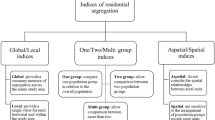Abstract
We propose a space-time stick-breaking process for the disease cluster estimation. The dependencies for spatial and temporal effects are introduced by using space-time covariate dependent kernel stick-breaking processes. We compared this model with the space-time standard random effect model by checking each model’s ability in terms of cluster detection of various shapes and sizes. This comparison was made for simulated data where the true risks were known. For the simulated data, we have observed that space-time stick-breaking process performs better in detecting medium- and high-risk clusters. For the real data, county specific low birth weight incidences for the state of South Carolina for the years 1997–2007, we have illustrated how the proposed model can be used to find grouping of counties of higher incidence rate.
Similar content being viewed by others
References
Assunção RM (2003) Space varying coefficient models for small area data. Environmetrics 14: 453–473
Banerjee S, Carlin B, Gelfand AE (2004) Hierarchical modeling and analysis for spatial data. Chapman and Hall, New York
Bernardinelli L, Clayton D, Montomoli C (1995) Bayesian estimates of disease maps: how important are priors?. Stat Med 14: 2411–2431
Best N, Richardson S, Thomas A (2005) A comparison of Bayesian spatial models for disease mapping. Stat Methods Med Res 14: 35–59
Duan JA, Guindani M, Gelfand AE (2007) Generalized spatial Dirichlet process models. Biomerika 94: 809–825
Dunson DB, Park JH (2008) Kernel stick-breaking processes. Biomerika 95: 307–323
Fang J, Madhavan S, Alderman MH (1999) Low birthweight: race and maternal nativity-impact of community income. Pediatrics 103: E5
Ferguson TS (1983) Bayesian density estimation by mixtures of normal distributions. In: Rizvi MH, Rustagi JS, Siegmund D (eds) Recent advances in statistics. Academic Press, New York, pp 287–302
Fernandez C, Green PJ (2002) Modelling spatially correlated data via mixtures: a Bayesian approach. J R Stat Soc Ser B 64: 805–826
Gelfand AE, Ghosh SK (1998) Model choice: a minimum posterior predictive loss. Biometrika 85: 1–11
Gelfand AE, Kottas A, MacEachern SN (2005) Bayesian nonparametric spatial modeling with Dirichlet process mixing. J Am Stat Assoc 100: 1021–1035
Gelfand AE, Vounatsou P (2003) Proper multivariate conditional autoregressive models for spatial data analysis. Biostatistics 4: 11–25
Gelman A, Carlin JB, Stern HS, Rubin DB (2004) Bayesian data analysis. Chapmann Hall, Boca Raton
Goldenberg RL, Culhane JF (2007) Low birth weight in the United States. Am J Clin Nutr 85:584S–590S
Grady S (2006) Racial disparities in low birthweight and the contribution of residential segregation: a multilevel analysis. Soc Sci Med 63: 3013–3029
Green J, Richardson S (2002) Hidden Markov models and disease mapping. J Am Stat Assoc 97: 1055–1070
Green PJ, Richardson S (2001) Modelling heterogeneity with and without the Dirichlet process. Scand J Stat 28: 355–375
Griffin JE, Steel MF (2006) Order-based dependent Dirichlet processes. J Am Stat Assoc 101: 179–194
Hennig C (2000) Identifiability of models for clusterwise linear regression. J Classif 17: 273–296
Hossain MM, Lawson AB (2010) Space-time Bayesian small area disease risk models: development and evaluation with a focus on cluster detection. Environ Ecol Stat 17: 73–95
Ishwaran H, James LF (2001) Gibbs sampling methods for stick-breaking priors. J Am Stat Assoc 96: 161–173
Ishwaran H, Zarepour M (2002) Exact and approximate sum representations for the Dirichlet process. Can J Stat 30: 269–283
Janevic T, Stein CR, Savitz DA, Kaufman JS, Mason SM, Herring AH (2010) Neighborhood deprivation and adverse birth outcomes among diverse ethnic groups. Ann Epidemiol 20: 445–451
Knorr-Held L (2000) Bayesian modelling of inseparable space-time variation in disease risk. Stat Med 19: 2555–2567
Knorr-Held L, Besag J (1998) Modelling risk from a disease in time and space. Stat Med 17: 2045–2060
Kottas A, Duan JA, Gelfand AE (2007) Modeling disease incidence data with spatial and spatial-temporal Dirichlet process mixtures. Biom J 49: 1–14
Lambert PC, Sutton AJ, Burton PR, Abrams KR, Jones DR (2005) How vague is vague? A simulation impact of the use of vague prior distributions in MCMC using winbugs. Stat Med 24: 2401–2428
Lawson AB, Song HR, Cai B, Hossain MM, Huang K (2010) Space-time latent component modeling of geo-referenced health data. Stat Med 29: 2012–2027
Lo AY (1984) On a class of Bayesian nonparametric estimates: I. Density estimates. Ann Stat 12: 351–357
Ohlssen DI, Sharples LD, Spiegelhalter DJ (2007) Flexible random-effects models using Bayesian semi-parametric models: application to institutional comparisons. Stat Med 26: 2088–2112
Pearl M, Braveman P, Abrams B (2001) The ralationship of neighborhood socioeconomic characteristics to birthweight among 5 ethnic groups in California. Am J Public Health 91: 1808–1814
Reich BJ, Fuentes M (2007) A multivariate semiparametric Bayesian spatial modeling framework for hurricane surface wind fields. Ann Appl Stat 1: 249–264
Richardson S, Thomas A, Best N, Elliott P (2004) Interpreting posterior relative risk estimates in disease-mapping studies. Environ Health Perspect 112: 1016–1025
Sethuraman J (1994) A constructive definition of Dirichlet priors. Stat Sin 4: 639–650
Spiegelhalter D, Thomas A, Best N, Lunn D (2003) WinBUGS user manual [1.4.]. MRC Biostatistics Unit, Institute of Public Health, Cambridge
Waller LA, Carlin BP, Xia H, Gelfand AE (1997) Hierarchical spatio-temporal mapping of disease rates. J Am Stat Assoc 92: S.607–S.617
Xia H, Carlin BP (1998) Spatio-temporal models with errors in covariates: mapping Ohio lung cancer mortality. Stat Med 17: 2025–2043
Author information
Authors and Affiliations
Corresponding author
Rights and permissions
About this article
Cite this article
Hossain, M.M., Lawson, A.B., Cai, B. et al. Space-time stick-breaking processes for small area disease cluster estimation. Environ Ecol Stat 20, 91–107 (2013). https://doi.org/10.1007/s10651-012-0209-0
Received:
Revised:
Published:
Issue Date:
DOI: https://doi.org/10.1007/s10651-012-0209-0




